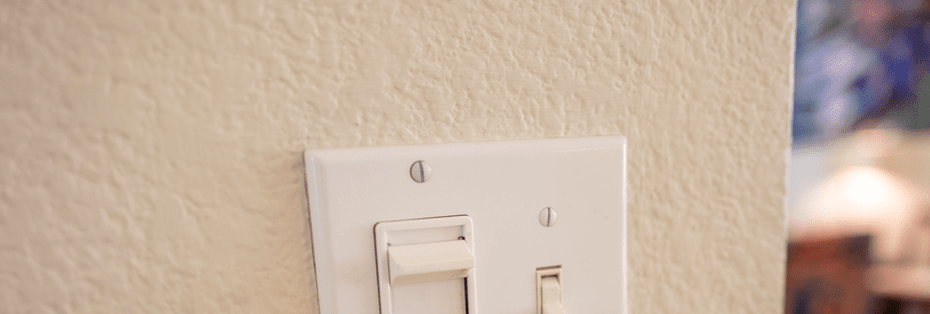How does a dimmer switch work? It’s pretty simple. A dimmer switch is a variable controller that regulates the flow of electricity, slowing down an electrical cycle to create a dimmed light or speeding it up to allow for brighter lighting. Sometimes bright lights can really harsh your mellow, so you might just do your best to avoid them, but there is another way to help your lighting better fit your mood and even save a few bucks on the electric bill while you’re at it. You may not have considered installing what is sometimes known as an adjustable light switch before, but a dimmer light switch can be a welcome addition throughout your home. Dimmer switches can change your home in ways you might never have considered before. You’ll appreciate the option to create a new vibe in any room whenever you want, opening a new dimension of atmosphere and enjoyment of your living spaces.
Energy savings and other benefits of dimmer switches
Change the mood instantly to one that suits you and your guests in the moment. Create undeniable ambience at the touch of a simple knob or fader switch. Some can even be programmed to adhere to your schedule. The benefits of dimmer switches are both immediately obvious and subtle, too, like the ability to incorporate this seemingly simple lighting-adjustment tool into your energy savings plan, helping you to conserve electricity and only use what you need when you need it. Bulbs last longer when they use less energy, and a dimmed bulb uses less.
In addition to longer bulb life, regular dimming can save you money and conserve the fossil fuels that likely supply a major portion of your local electric department’s electricity. For example, dimming your lights in general around the home by about 30% can save you about 30% in related energy costs. The flexibility of having different rooms lit at different levels allows you to generate a variety of different moods and feelings around your home. Programming bedroom lights to dim at certain times can help train your body to relax for sleep.
Types of dimmer switches
From a simple two-way dimmer switch to a more modern LED dimmer switch, many types of light switches feature dimming functionality. These include smart dimmer switches, three-way dimmer switches and light-emitting diode (LED) switches. Some already energy-efficient compact fluorescent light (CFL) bulbs are also dimmable. Once you decide on the bulbs you’d prefer, you’ll also want to consider which controllers will work best for your needs. These include rotary-style knobs that turn left and right, and toggle switches that fade or amplify the light by sliding up and down like a fader on a recording console. Rocker controls and toggle switches feature additional dim-adjustment pieces alongside a traditional on/off controller. More complex “scene selection” controls enable controlled switching and dimming lights in groups and have multiple buttons for various lighting settings, allowing the user to set the scene with layered lighting design. Wall-box dimmers mount inside the wall switch box and are designed to match existing room fixtures. These can be integrated, which can control multiple presets throughout an entire room, or be touchable dimmers that respond to a simple touch of the hand without a switch. Some even work with remote controls, enabling you to change any room’s lighting from one location as easily as changing the channel on your TV.
Best locations for installing dimmer switches
For optimal energy savings, you’ll want to use dimmers throughout every room in your home, but that may not be a practical starting place. First, consider installing dimmer switches where they could have the most impact, particularly in the rooms where you think you can get by with less light than is typically available. Also consider rooms where the demand for lighting is unpredictable. These are opportunities to save energy with dimmer switches. Generally speaking, any room could be a good candidate for dimmers, but bedrooms, kitchens, bathrooms, hallways, living rooms, dens, porches or decks are usually good choices where dimming lights can make an impact on both your lifestyle and your energy bills.
How to install dimmer switches
If you’re wondering how to install a dimmer switch, even if you’ve already been searching online for “change light switch to dimmer,” or “replace dimmer switch,” you’re in the right place. We’ve got you covered on the how-to with a few simple steps. You’ve likely heard this one before, but start by reading the directions — always a reliable way to orient yourself to the task at hand from the outset. New bulbs and dimmer switches will come with them. Next, turn off the power to the circuit you’ll be working on, remove the existing switch, expose the wires, and test them with a voltage meter to make sure the power is off. Turn off the switch itself, reattach the wires to the new dimmer switch, and replace the entire mechanism into the wall. Once the dimmer has been installed and the cover plate has been reattached to the box, turn the power back on from the breaker box. If you have any trouble, don’t hesitate to call a professional for help.
Potential dimmer switch drawbacks
Though they are compatible with many lighting systems, unless your home’s wiring has been designed specifically for the task, dimmer switches are unlikely to be compatible with every light source or fixture in your home. Take some time to investigate whether the specific fixtures (and associated wiring) will work with a dimmer before attempting to install it yourself. While some DIY homeowners relish the task and consider dimmer switch installation easy, others are much more comfortable having a professional evaluate the situation and take care of the job.
We hope our post on dimmer switches has helped you decide about whether they’re a good choice for you and your home. While you’re here, you might also be interested in reading some of our other posts on topics like how to turn your house into a more energy-efficient home, along with our helpful tips on how to cut energy costs at home. If you’re considering the addition of one or more of the latest in smart home appliances, check out our ultimate smart home checklist and dig into our overview of which smart appliances are right for you. Thanks for stopping by!
The information in this article is intended to provide guidance on the proper maintenance and care of systems and appliances in the home. Not all of the topics mentioned are covered by our home warranty or maintenance plans. Please review your home warranty contract carefully to understand your coverage.

